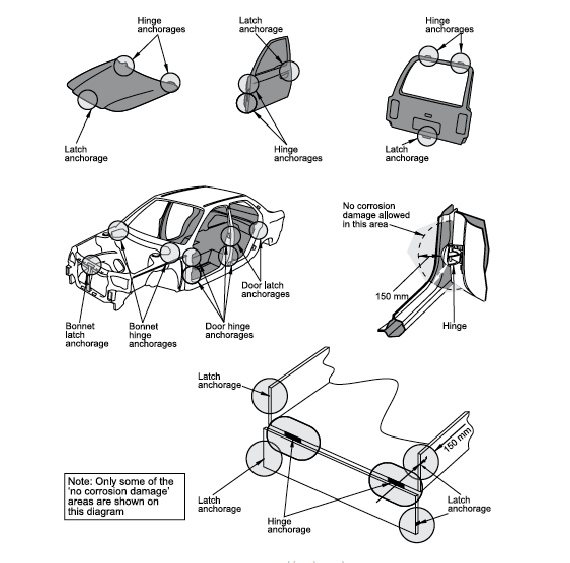Entrance and exit
6-1 Door and hinged panel retention systems
Reasons for rejection
Mandatory equipment
1. A motor vehicle fitted with doors used by the driver or passengers for entrance and exit of the motor vehicle do not have a door retention system.
Equipment condition
2. A hinge for a door or other hinge panel is not securely attached to both the vehicle body and to the door or other hinged panel due to loose connections, corrosion or other damage.
3. A door used for entrance and exit cannot be opened from the inside.
4. A child safety lock or similar safety device cannot be de-activated.
5. There is corrosion damage within 150mm of the hinge of a door or other hinged panel (Figure 6-1-1).
6. There is corrosion damage (Note 1) within 150mm of the latch of a door or other hinged panel (Figure 6-1-1).
Equipment performance
7. A door used for entrance and exit does not open or close easily.
8. A door or other hinged panel does not remain secure in a closed or locked position.
Modifications
9. A modification (Note 1) affects the door retention system, and:
a) is not excluded from the requirements for LVV specialist certification (Table 6-1-1), and
b) is missing proof of LVV specialist or accepted overseas certification, ie:
i. the vehicle is not fitted with a valid LVV certification plate, or
ii. the operator is not able to produce a valid modification declaration or authority card , or
iii. the vehicle has not been certified to an accepted overseas system as described in Technical bulletin 13 .
Note 1 Definitions
Corrosion damage is where the metal has been eaten away, which is evident by pitting. The outward signs of such corrosion damage is typically displayed by the lifting or bubbling of paint. In extreme cases, the area affected by the corrosion damage will fall out and leave a hole.
Modify means to change a vehicle from its original state by altering, substituting, adding or removing a structure, system, component or equipment, but does not include repair.
Repair means to restore a damaged or worn vehicle, its structure, systems, components or equipment to within safe tolerance of its condition when manufactured, including replacement with undamaged or new structures, systems, components or equipment.
Table 6-1-1. Modifications that do not require LVV certification
Fitting of or modification to: | LVV certification is never required: |
|---|---|
Any modification for the purposes of law enforcement or the provision of emergency services |
|
Figure 6-1-1. Hinge and latch anchorages
No corrosion damage is allowed within 150mm of a circle around the outside of hinge or latchcomponents.
Note Image is indicative only.

Summary of legislation
Applicable legislation
- Land Transport Rule: Door Retention Systems 2001
- Land Transport Rule: Vehicle Standards Compliance 2002, section 7.4.
Mandatory equipment
1. A motor vehicle fitted with doors used by the driver or passengers for entrance and exit of the motor vehicle must have a door retention system.
Permitted equipment
2. The door retention system on doors to the rear of the driver’s seat may incorporate safety devices installed during the manufacture of the vehicle to prevent the doors from being opened from the inside of the vehicle (eg child safety locks).
Equipment condition
3. A door retention system and its mountings must be safe and structurally sound.
4. A door used for the entrance and exit of the driver or passengers must be operable by any occupant seated by the door from inside the motor vehicle.
5. The vehicle must be designed and constructed using components and materials that are fit for their purpose, and within safe tolerance of its state when manufactured or modified.
Equipment performance
6. A door retention system must be in good working order.
7. A door used for entrance and exit must open and close easily.
8. A door used for entrance and exit must remain secure in a closed position during the operation of the motor vehicle.
Modifications
9. A modification that affects the door retention system must be inspected and certified by a low volume vehicle specialist certifier, unless the vehicle:
a) is excluded from the requirement for LVV specialist certification (Table 6-1-1), and
b) has been inspected in accordance with the requirements in this manual, including those for equipment, condition and performance.
Page amended 1 December 2016 (see amendment details).